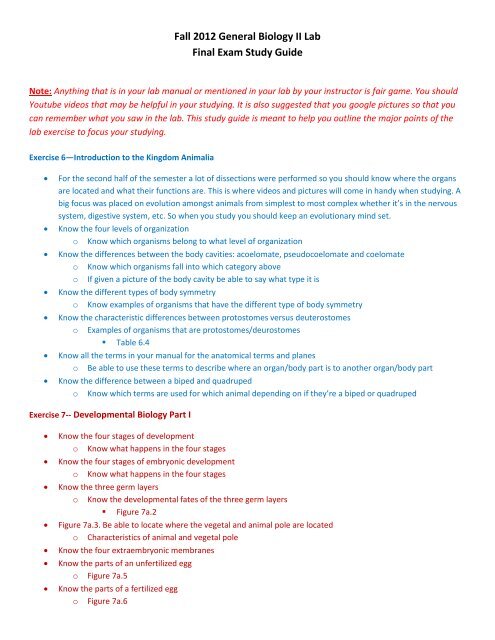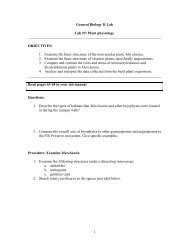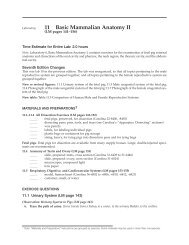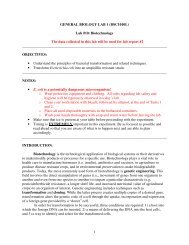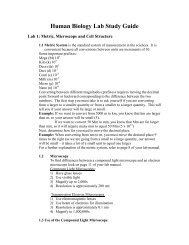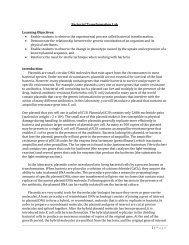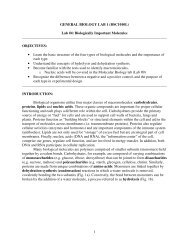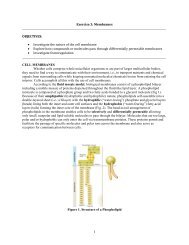Fall 2012 General Biology II Lab Final Exam Study Guide
Fall 2012 General Biology II Lab Final Exam Study Guide
Fall 2012 General Biology II Lab Final Exam Study Guide
Create successful ePaper yourself
Turn your PDF publications into a flip-book with our unique Google optimized e-Paper software.
<strong>Fall</strong> <strong>2012</strong> <strong>General</strong> <strong>Biology</strong> <strong>II</strong> <strong>Lab</strong><strong>Final</strong> <strong>Exam</strong> <strong>Study</strong> <strong>Guide</strong>Note: Anything that is in your lab manual or mentioned in your lab by your instructor is fair game. You shouldYoutube videos that may be helpful in your studying. It is also suggested that you google pictures so that youcan remember what you saw in the lab. This study guide is meant to help you outline the major points of thelab exercise to focus your studying.Exercise 6—Introduction to the Kingdom AnimaliaFor the second half of the semester a lot of dissections were performed so you should know where the organsare located and what their functions are. This is where videos and pictures will come in handy when studying. Abig focus was placed on evolution amongst animals from simplest to most complex whether it’s in the nervoussystem, digestive system, etc. So when you study you should keep an evolutionary mind set.Know the four levels of organizationo Know which organisms belong to what level of organizationKnow the differences between the body cavities: acoelomate, pseudocoelomate and coelomateo Know which organisms fall into which category aboveo If given a picture of the body cavity be able to say what type it isKnow the different types of body symmetryo Know examples of organisms that have the different type of body symmetryKnow the characteristic differences between protostomes versus deuterostomeso <strong>Exam</strong>ples of organisms that are protostomes/deurostomes• Table 6.4Know all the terms in your manual for the anatomical terms and planeso Be able to use these terms to describe where an organ/body part is to another organ/body partKnow the difference between a biped and quadrupedo Know which terms are used for which animal depending on if they’re a biped or quadrupedExercise 7-- Developmental <strong>Biology</strong> Part IKnow the four stages of developmento Know what happens in the four stagesKnow the four stages of embryonic developmento Know what happens in the four stagesKnow the three germ layerso Know the developmental fates of the three germ layers• Figure 7a.2Figure 7a.3. Be able to locate where the vegetal and animal pole are locatedo Characteristics of animal and vegetal poleKnow the four extraembryonic membranesKnow the parts of an unfertilized eggo Figure 7a.5Know the parts of a fertilized eggo Figure 7a.6
Know the function of all the parts of an eggo Table 7a.2Be able to figure out what stage the chick embryos is if given on a slideo 24-hour, 33-hour, 72-hour chick embryos• Use pictures from your manual or google them• Be able to explain why you know it’s at that hour (ie: because the heart is developed, etc)o What happens in these stagesFrog development slideso Know how to tell which stage of development it’s in if given a slideo Know how to locate structures like the animal and vegetal pole and the blastocoelKnow what complete versus incomplete metamorphosis iso Know examples of organisms that are complete/incomplete• Frogs = complete Know specific differences between tadpole and frogo Dieto Anatomyo Habitato Organ Systems• Crickets = incompleteNymphDifferences between nymph, instar and adultOvipositorHow to tell a difference between a male and femaleExercise 8 Nervous SystemKnow the different types of nervous system that the organisms mentioned in your manual have.Know the parts of the earthworm nervous systemKnow the major parts of the sheep braino Know the functions of the parts of the brainKnow the parts of the rat brainKnow the parts of the shark brainWhat is cephalization?o Which organisms that you dissected are cephalized?If given several organisms be able to put them in order by evolution (least to most evolved or most to leastevolved)What organisms responded to which stimuli? Be specific. Why?Exercise 9 Digestive SystemKnow what the following terms mean and examples of organisms that fall into these categories:o Ingestive eaterso Absorptive feederso Suspension feederso Substrate feederso Fluid feeders
Incomplete versus complete digestive systemso Know examples of organisms that fall into those two categoriesKnow the 3 digestion experiment that you did in lab. Note: on the quiz/exam you will answer the questionsaccording to what SHOULD happen. If you’re given the information as to what is in each test tube you should beable to explain what would happen and WHY.o Starch experimento Protein experimento Fat experimento Know what the end-product is for each experiment; ie: maltose, polypeptides, fatty acids and glycerolo Know what enzymes are involved• Where are those enzymes located in the body• Do NOT worry about memorizing colors!!o Know which test tubes were:• Positive controls• Positive results• Negative controls• Negative resultsKnow an overview of the digestive system and what happens in the organsBe able to identify the digestive organs for the following organisms:o Earthworm• Mouth• Esophagus• Crop• Gizzard• Intestine• Anuso Rat• Mouth• Esophagus• Stomach• Liver• Intestines• Anuso Shark• Mouth• Esophagus• Liver• Intestine• Stomach• Anuso Pigeon• Mouth• Esophagus• Crop• Gizzard• Intestines
ooooooShark• Gills• Gill rakers• Gill arches• Gill slitsLeopard frog• Remember they’re able to do cutaneous respiration• Lungs• You should also know the rest of the organs on the frogPig• Trachea• lungsRat• Trachea• lungsPigeon• Lungs• Air sacs• You should also know the rest of the organs on the pigeonArthropods• Spiracles/tracheaKnow how many chambers different organisms have in their heartKnow the difference between an open and closed circulatory systemo Know which organisms have what type (open or closed)Exercise 11 Endocrine System and Animal BehaviorBe able to tell the difference between a male and female crayfisho How can you tell?Different agonistic behaviors that crayfish demonstrateo What is an agonistic behavior?• Intrinsic versus extrinsic factorso Meral spreado What kinds of behavior shows the crayfish trying to be submissive?o What kinds of behavior shows the crayfish trying to be aggressive?What was the purpose of the saline in the experiment with the crayfish?What was the purpose of the serotonin in the experiment with the crayfish?o What does the serotonin do to the crayfish?What’s an ethogram?o Know how to construct an ethogram.o Know how to interpret an ethogram.What was the point of changing the water in the fighting arena before the second fight?Know the different parts of the crayfishWhat are the reasons that animals are aggressive?


